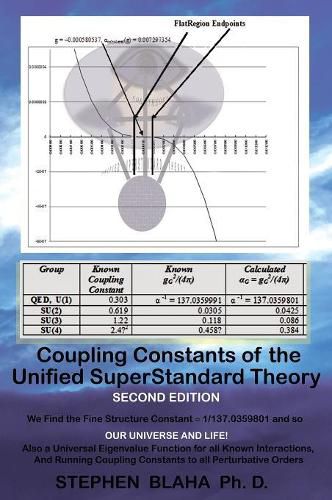Readings Newsletter
Become a Readings Member to make your shopping experience even easier.
Sign in or sign up for free!
You’re not far away from qualifying for FREE standard shipping within Australia
You’ve qualified for FREE standard shipping within Australia
The cart is loading…






The hundred year pursuit of the value of the electromagnetic fine structure constant called alpha appears to have reached a conclusion in this book. In perhaps the happiest of theoretical circumstances it appears that alpha's value is determined by the internal dynamics of Quantum Electrodynamics (QED). Its origin is not cosmological or otherwise. In addition this book gives good reason to believe that the Weak and Strong interaction coupling constants are also determined internally dynamically. In all these cases no arbitrary external constants appear so there is no room for "fudging." The book also "explains" the difference in the values of Standard Model interactions. Running coupling constants are calculated and shown to have an asymptotic power law behavior with asymptotic freedom for non-abelian interactions, and increasing value for QED.
The study of these features is closely related to a universal form for the coupling constant eigenvalue functions. There is also a universal form for coupling constants of the form "alpha = v tan(h)" where alpha is a coupling constant, and v and h are numeric constants. This form is analogous to the Madhava-Leibniz expression for pi = arctan(1). Thus alpha is put on the same footing as the universal constant pi.
An important result of these studies is the implication that we are at the deepest level of fundamental elementary particle physics. There is no theoretical need for a deeper level and absolutely no experimental evidence either. Analogies with condensed matter physics suggesting a possible deeper level are interesting--but quite unlikely.
Perhaps the best support for the author's view that we have reached ground zero is the extraordinary accuracy of the theoretical QED predictions for hydrogen atomic levels, magnetic moments, Coulomb scattering, and so on. The agreement of theory and experiment is incredible making a yet deeper theory extremely unlikely. There are more phenomena likely in Physics but they will appear in new phenomena that augment known theory. Our books on the Unified SuperStandard Theory illustrate these possibilities.
Our theory of fine structure coupling constants supports our understanding of the features of the universe, the features of life, and the gamut of chemistry. This new understanding of the origin of coupling constants is a gusher!
The book is illustrated with many plots and diagrams as well as a summary of the Unified SuperStandard Theory. This edition contains the first edition with some minor clarifications. Most importantly, it uses an intermediate renormalization to map the QED eigenvalue function F1 to F2.
$9.00 standard shipping within Australia
FREE standard shipping within Australia for orders over $100.00
Express & International shipping calculated at checkout
The hundred year pursuit of the value of the electromagnetic fine structure constant called alpha appears to have reached a conclusion in this book. In perhaps the happiest of theoretical circumstances it appears that alpha's value is determined by the internal dynamics of Quantum Electrodynamics (QED). Its origin is not cosmological or otherwise. In addition this book gives good reason to believe that the Weak and Strong interaction coupling constants are also determined internally dynamically. In all these cases no arbitrary external constants appear so there is no room for "fudging." The book also "explains" the difference in the values of Standard Model interactions. Running coupling constants are calculated and shown to have an asymptotic power law behavior with asymptotic freedom for non-abelian interactions, and increasing value for QED.
The study of these features is closely related to a universal form for the coupling constant eigenvalue functions. There is also a universal form for coupling constants of the form "alpha = v tan(h)" where alpha is a coupling constant, and v and h are numeric constants. This form is analogous to the Madhava-Leibniz expression for pi = arctan(1). Thus alpha is put on the same footing as the universal constant pi.
An important result of these studies is the implication that we are at the deepest level of fundamental elementary particle physics. There is no theoretical need for a deeper level and absolutely no experimental evidence either. Analogies with condensed matter physics suggesting a possible deeper level are interesting--but quite unlikely.
Perhaps the best support for the author's view that we have reached ground zero is the extraordinary accuracy of the theoretical QED predictions for hydrogen atomic levels, magnetic moments, Coulomb scattering, and so on. The agreement of theory and experiment is incredible making a yet deeper theory extremely unlikely. There are more phenomena likely in Physics but they will appear in new phenomena that augment known theory. Our books on the Unified SuperStandard Theory illustrate these possibilities.
Our theory of fine structure coupling constants supports our understanding of the features of the universe, the features of life, and the gamut of chemistry. This new understanding of the origin of coupling constants is a gusher!
The book is illustrated with many plots and diagrams as well as a summary of the Unified SuperStandard Theory. This edition contains the first edition with some minor clarifications. Most importantly, it uses an intermediate renormalization to map the QED eigenvalue function F1 to F2.